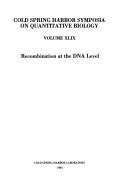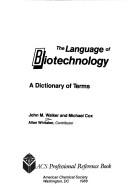| Listing 1 - 10 of 117 | << page >> |
Sort by
|
Book
ISBN: 2930275103 Year: 2004 Publisher: Namen
Abstract | Keywords | Export | Availability | Bookmark
 Loading...
Loading...Choose an application
- Reference Manager
- EndNote
- RefWorks (Direct export to RefWorks)
Book
ISBN: 9282639967 Year: 1992 Publisher: Luxembourg Office for official publications of the European communities
Abstract | Keywords | Export | Availability | Bookmark
 Loading...
Loading...Choose an application
- Reference Manager
- EndNote
- RefWorks (Direct export to RefWorks)

Abstract | Keywords | Export | Availability | Bookmark
 Loading...
Loading...Choose an application
- Reference Manager
- EndNote
- RefWorks (Direct export to RefWorks)
575.08:577.21 --- Recombinant DNA --- -rDNA --- DNA --- Genetic engineering --- Genetic recombination --- Genetic vectors --- Genetic engineering, genetic manipulation, recombinant DNA --- Congresses --- Congresses. --- -Genetic engineering, genetic manipulation, recombinant DNA --- 575.08:577.21 Genetic engineering, genetic manipulation, recombinant DNA --- -575.08:577.21 Genetic engineering, genetic manipulation, recombinant DNA --- rDNA --- Acides désoxyribonucléiques. Réparation. (Congrès) --- Desoxyribonucleïnezuren. Herstellingen. (Congres) --- RECOMBINATION, GENETIC --- GENETICS
Book
ISBN: 9070157721 Year: 1986 Publisher: Leiden Stichting Bio-Wetenschappen en Maatschappi
Abstract | Keywords | Export | Availability | Bookmark
 Loading...
Loading...Choose an application
- Reference Manager
- EndNote
- RefWorks (Direct export to RefWorks)
biotechnologie --- Didactics of biology --- maatschappij --- biologie --- Biotechnology --- 575.08:577.21 --- #WPLT:dd.prof.J.Vendrig --- Biotechnologie 663 --- 572 --- Biotechnologie --- Genetic engineering, genetic manipulation, recombinant DNA --- 575.08:577.21 Genetic engineering, genetic manipulation, recombinant DNA
Dissertation

ISBN: 9789088260469 Year: 2008 Volume: 787 Publisher: Leuven K.U.Leuven. Faculteit Bio-ingenieurswetenschappen
Abstract | Keywords | Export | Availability | Bookmark
 Loading...
Loading...Choose an application
- Reference Manager
- EndNote
- RefWorks (Direct export to RefWorks)
A genome-wide T-DNA tagging strategy was pursued for the characterization and isolation of novel banana promoters. Embryogenic cell suspensions were transformed via Agrobacterium tumefaciens containing a promoterless, codon-optimized luciferase gene either without (luc+) or with an intron (luc+INT) next to the right T-DNA border. Approximately 89,000 transgenic cell colonies were first screened for baseline luciferase (LUC) activity at 26°C two to three months after transformation. A 1.6- to 4.3-fold higher tagging frequency was obtained with the luc+INT containing vector (pKCKUL1) than with the luc+ vector (pETKUL2). Screening in real-time then continued under controlled temperature conditions in which LUC activity was monitored during a gradual decrease to different low temperature (LT) treatments including 18°C, 16°C, 12°C and 8°C. Luciferase activation frequency in cell colonies subjected to 26°C and different LT treatments ranged from 0.17% to 2.69%. Observed patterns included an enhanced, decreased or status quo LUC activity at LT relative to the 26°C LUC activity. Transgenic cell colonies responsive to 8°C were regenerated to in vitro plants with a real-time screening for LT regulated LUC activation at each developmental stage. The tagged lines ET2-17 and ET2-42 showed an enhanced LUC activity at 8°C at the cell colony stage. However, LUC activity of the latter line was not up-regulated by LT anymore at the shoot induction and in vitro plant stages. On the other hand, in the tagged line ET2-17 the up-regulation of LUC activity by LT at cell colony stage (10.7- fold) remained present at the shoot induction stage (2.5-fold up-regulation) but was absent at in vitro plant stage. In addition, other promoter-tagged lines with different levels of LUC activity at 26°C at cell colony stage showed a decrease of LUC activity at 8°C during the subsequent stages of the in vitro regeneration process (lines ET2-34, ET2-85 and ET2-156). The number of T-DNA inserts in ten independent promoter-tagged lines tested averaged 3.6 with a range from 1 (line ET2-34) to 5 (lines ET2-17 and ET2-156). Isolation of T-DNA flanking sequences was accomplished via TAIL-PCR and I-PCR. Sequence analysis of these flanks revealed the presence of direct tandem repeats, vector backbone and/or T-DNA rearrangements in up to half of the lines analyzed. The lines ET2-49, ET2-89, ET2-111 and ET2-156 contained in one RB T-DNA flanking (5’-tagged) sequence the enhanced CaMV 35S promoter with part of the selectable marker gene neo from the tagging construct. Continuity of sequence between the corresponding right and left border sequences was revealed by linking PCR using flanking sequence specific primers. In silico analysis of the four 5’-tagged banana sequences in line ET2-17 suggested that two candidate promoters were tagged. The 5’-tagged sequence in line ET2-34 harbored a repetitive region, while in line ET2-85 three 5’-tagged sequences were retrieved with one most likely linked to a gene and containing a near-canonical TATA box. An RT-PCR approach was followed to identify and confirm the sequence that activated LUC expression, which is of paramount importance in lines carrying multiple T-DNA copies. A forward primer annealing to the 5’-tagged sequence near (within 1 to 70 bp) the RB T-DNA sequence was employed in combination with a reverse primer complementary to the luc+ gene. Transcriptional fusion between (the) 5’-tagged sequence(s) and the luc+ gene was detected in tagged lines ET2-17, ET2-34, ET2-85 and ET2-156. Candidate promoter sequences were cloned upstream of the uidAINT reporter gene and back-transformed to banana. One (17-1) of two transcriptionally active tagged sequences in the promoter-tagged line ET2-17 was found active in back-transformed banana lines throughout in vitro development confirming its promoter characteristics. The LT up-regulation of promoter sequence 17-1 in back-transformed lines at early undifferentiated cell colony stage resembled that of the original promoter-tagged line ET2-17. In contrast, the 5’-tagged sequence 34-1 did not show promoter activity in back-transformed cultures irrespective of the temperature treatment and developmental stage. Finally, the promoter activity of the 5’-tagged sequence 85-1 in back-transformed lines was similar to the relatively strong activity in the original promoter-tagged line ET2-85. In conclusion, T-DNA tagging has proven a reliable and reproducible method to characterize and isolate novel promoters in banana. Despite their relatively low activity in in vitro cultures compared to the maize ubiquitin promoter, the discovered promoters might be useful for banana improvement which warrants further research. A genome-wide T-DNA tagging strategy was pursued for the characterization and isolation of novel banana promoters. Banana embryogenic cell suspensions were transformed via Agrobacterium tumefaciens containing a promoterless, codon-optimized luciferase (luc+) gene next to the right T-DNA border. Approximately 89,000 transgenic banana cell colonies were screened for luminescence two to three months after transformation using a sophisticated camera system in a light-tight box. Screening occurred under controlled temperature conditions in which luminescence was monitored in real-time at 26°C followed by a gradual decrease to different low temperatures (LT) including 18°C, 16°C, 12°C and 8°C. The frequency of cell colonies showing luminescence at 26°C and the different LT treatments ranged from 0.17% to 2.69%. Transgenic cell colonies responsive to 8°C (i.e. showing an enhanced or repressed luciferase expression pattern) were regenerated to plantlets and luminescence was monitored at different in vitro developmental stages. With increasing differentiation the number of lines with LT up-regulated LUC expression decreased. Banana plants showing luminescence were analyzed for the T-DNA copy number by Southern hybridization. T-DNA inserts averaged 3.6 (range from 1 to 5) in 10 independent lines tested. DNA sequences flanking the right and left T-DNA borders were isolated via TAIL-PCR and inverse PCR. Continuity of sequence between the corresponding right and left border flanking sequences was revealed by linking PCR using flanking sequence specific primers. RT-PCR analysis was performed in lines with multiple inserts to identify and confirm the sequence that activated luciferase expression. Four candidate promoter sequences which were transcriptionally fused to the luc+ were cloned upstream of a uidAINT reporter gene and back-transformed to banana, which confirmed promoter activity for two sequences in in vitro cultures. Promoter activity in mature banana plants remains to be investigated. To summarize, a high-throughput T-DNA tagging system has enabled us to characterize and isolate novel banana promoters with potential for a number of downstream applications including banana improvement via genetic modification.
Academic collection --- 634.771 <043> --- 575.08:577.21 --- Musa species in general--Dissertaties --- Genetic engineering, genetic manipulation, recombinant DNA --- Theses --- 575.08:577.21 Genetic engineering, genetic manipulation, recombinant DNA --- 634.771 <043> Musa species in general--Dissertaties
Book
ISBN: 0442317409 9780442317409 Year: 1986 Publisher: Wokingham Van Nostrand Reinhold
Abstract | Keywords | Export | Availability | Bookmark
 Loading...
Loading...Choose an application
- Reference Manager
- EndNote
- RefWorks (Direct export to RefWorks)
DNA, Recombinant --- Cloning, Molecular --- 575.08:577.21 --- Genetic engineering, genetic manipulation, recombinant DNA --- 575.08:577.21 Genetic engineering, genetic manipulation, recombinant DNA --- recombinant --- recombinant. --- Recombinant. --- Dna --- Molecular cloning. --- Molecular biology --- Biotechnology --- DNA, Recombinant.
Book
ISBN: 3540185569 0387185569 3642731597 3642731570 Year: 1988 Volume: vol 18 Publisher: Berlin Springer
Abstract | Keywords | Export | Availability | Bookmark
 Loading...
Loading...Choose an application
- Reference Manager
- EndNote
- RefWorks (Direct export to RefWorks)
Plant biotechnology --- 575.08:577.21 --- 581.17 --- 581.17 Physiology of the cell --- Physiology of the cell --- 575.08:577.21 Genetic engineering, genetic manipulation, recombinant DNA --- Genetic engineering, genetic manipulation, recombinant DNA --- Congresses --- Biological techniques --- Phytohistology. Phytocytology --- Biotechnology
Book
ISBN: 9068341081 Year: 1993 Publisher: Brussel Aramith Uitgevers
Abstract | Keywords | Export | Availability | Bookmark
 Loading...
Loading...Choose an application
- Reference Manager
- EndNote
- RefWorks (Direct export to RefWorks)

ISBN: 0841214891 0841214905 Year: 1988 Publisher: Washington, DC American Chemical Society
Abstract | Keywords | Export | Availability | Bookmark
 Loading...
Loading...Choose an application
- Reference Manager
- EndNote
- RefWorks (Direct export to RefWorks)
Biotechnology --- Dictionaries --- Biotechnology - Dictionaries. --- 575.08:577.21 --- 66.098 <031> --- 575.08:577.21 Genetic engineering, genetic manipulation, recombinant DNA --- Genetic engineering, genetic manipulation, recombinant DNA --- 66.098 <031> Biological processes. Biotechnology--Encyclopedieën. Lexica --- Biological processes. Biotechnology--Encyclopedieën. Lexica
Book
Abstract | Keywords | Export | Availability | Bookmark
 Loading...
Loading...Choose an application
- Reference Manager
- EndNote
- RefWorks (Direct export to RefWorks)
| Listing 1 - 10 of 117 | << page >> |
Sort by
|

 Search
Search Feedback
Feedback About UniCat
About UniCat  Help
Help News
News